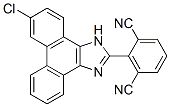All AbMole products are for research use only, cannot be used for human consumption.

MF63 potently inhibited the human mPGES-1 enzyme (IC50=1.3 nM), with a high degree (>1000-fold) of selectivity over other prostanoid synthases. Microsomal prostaglandin E synthase-1 (mPGES-1) is a terminal prostaglandin E (2) (PGE (2)) synthase in the cyclooxygenase pathway. Inhibitors of mPGES-1 may block PGE (2) production and relieve inflammatory symptoms. In rodent species, MF63 strongly inhibited guinea pig mPGES-1 (IC50=0.9 nM) but not the mouse or rat enzyme. In addition, MF63 did not cause NSAID-like gastrointestinal toxic effects, such as mucosal erosions or leakage in the KI mice or nonhuman primates, although it markedly inhibited PGE2 synthesis in the KI mouse stomach.

Oncotarget. 2016 Jul 12;7(28):44350-44364.
Linking microsomal prostaglandin E Synthase-1/PGE-2 pathway with miR-15a and -186 expression: Novel mechanism of VEGF modulation in prostate cancer
MF63 purchased from AbMole

Am J Physiol Gastrointest Liver Physiol. 2016 Jun 1;310(11):G1071-80.
Microsomal prostaglandin E synthase-1 protects against Fas-induced liver injury.
MF63 purchased from AbMole

Endocr Relat Cancer. 2015 Aug;665-78.
mPGES-1 in prostate cancer controls stemness and amplifies epidermal growth factor receptor-driven oncogenicity.
MF63 purchased from AbMole
| Cell Experiment | |
|---|---|
| Cell lines | A549 cells |
| Preparation method | A549 cells were seeded in 96-well dishes at a density of 25,000 cells/well and incubated for 20 h in RPMI 1640 medium supplemented with 2% fetal bovine serum (FBS). The cells were then incubated with 10 ng/ml IL-1 for 24 h in the presence of a vehicle or inhibitor from a 100-fold concentrated DMSO stock solution in a medium containing 2 or 50% FBS. Concentrations of PGE2 and PGF2 in the cell-free medium were measured by EIA (Assay Designs Inc.). IC50 values were derived from eight-point titrations. |
| Concentrations | 0.01~100 µ M |
| Incubation time | 24 h |
| Animal Experiment | |
|---|---|
| Animal models | mPGES-1 Knock-In Mice |
| Formulation | a suspension in 0.5% methylcellulose |
| Dosages | 100 mg/kg |
| Administration | oral gavage |
| Molecular Weight | 378.81 |
| Formula | C23H11ClN4 |
| CAS Number | 892549-43-8 |
| Solubility (25°C) | DMSO 42 mg/mL |
| Storage |
Powder -20°C 3 years ; 4°C 2 years In solvent -80°C 6 months ; -20°C 1 month |
| Related PGE synthase Products |
|---|
| Vipoglanstat
Vipoglanstat (BI 1029539) is an inhibitor of microsomal prostaglandin E synthase-1 (mPGES-1; IC50 = ≤0.5 nM in isolated human whole blood). Vipoglanstat reduces LPS-induced increases in the influx of neutrophils and levels of cytokines in bronchoalveolar lavage fluid (BALF), as well as the expression of PTGES, the gene encoding mPGES-1, Cox2, and Icam1 in the lung parenchyma, in a human PTGES knock-in mouse model of acute lung injury when administered at a dose of 30 mg/kg. |
| mPGES1-IN-7
mPGES-1-IN-2 is a benzimidazole-based mPGES-1 inhibitor that also inhibits adipophysin PGD synthase (I-PGDS) (5 μM, IR=60 %). |
| (E)-KME-4
(E)-KME-4 is a potent inhibitor of prostaglandin synthetase (PGS) with an IC50 of 0.28 μM; also inhibits 5-lipoxygenase with an IC50 of 1.05 μM. |
| Friluglanstat
Friluglanstat is a prostaglandin E synthase (mPGES-1) inhibitor, with anti-inflammatory activity. |
| UT-11
UT-11 is a potent and brain-permeable microsomal prostaglandin E synthase-1 (mPGES-1) inhibitor. |
All AbMole products are for research use only, cannot be used for human consumption or veterinary use. We do not provide products or services to individuals. Please comply with the intended use and do not use AbMole products for any other purpose.


Products are for research use only. Not for human use. We do not sell to patients.
© Copyright 2010-2024 AbMole BioScience. All Rights Reserved.
